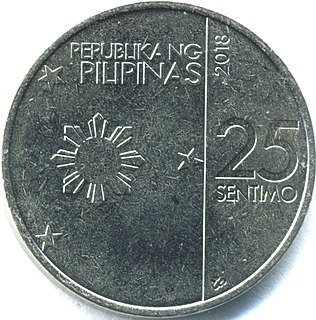
Tynwald, or more formally, the High Court of Tynwald or Tynwald Court, is the legislature of the Isle of Man. It claims to be the oldest continuous parliamentary body in the world. It consists of two chambers, known as the branches of Tynwald: the directly elected House of Keys and the indirectly chosen Legislative Council. When the two chambers meet together once a month, they become Tynwald Court.
The Manx pound is the currency of the Isle of Man, in parity with the pound sterling. The Manx pound is divided into 100 pence. Notes and coins, denominated in pounds and pence, are issued by the Isle of Man Government.
The Thailand five-satang coin is a unit of currency equivalent to one-twentieth of a Thai baht. It was introduced in 1908 as a coin with a hole through its middle, which was minted until 1939. In 1946 the hole was removed and the new Thai monarch featured on the obverse: Rama IX. In 1996 a five-satang coin marked the 50th anniversary of his reign.
The Thailand ten-satang coin is a currency unit equivalent to one-tenth of a Thai baht. It is rare in circulation but used in banking transactions. It was introduced in 1908 as a coin with a hole through its middle and minted until 1939.

The New Zealand twenty-cent coin is the second-lowest-denomination coin of the New Zealand dollar. The 20-cent coin was introduced when the New Zealand dollar was introduced on 10 July 1967, replacing the New Zealand florin coin. Its original reverse of a kiwi was changed in 1990 when the image was moved onto the one-dollar coin. In 2006 its size was reduced and its edge altered to a Spanish flower as part of a revision of New Zealand's coins, which also saw its alloy become nickel-plated steel.

The one-dollar coin is the fourth-highest and fourth-lowest denomination coin of the Hong Kong dollar.
This article concerns the coins of the New Zealand dollar.

The twenty-five øre coin was a coin of the Danish krone. It was the lowest-denomination coin in the country when it was demonetised on 1 October 2008.
The ten-cent coin is the lowest-denomination circulating coin of the Hong Kong dollar. With a diameter of 17.5 mm and a mass of 1.85 g it is also the smallest in size and weight. It is the oldest coin denomination to still be in circulation in Hong Kong. Since its first issue in 1863, there has only been one period (1942–1947) where the coin was not in use.
The five dollar coin is the second-highest denomination coin of the Hong Kong dollar. It replaced the five dollar banknotes in 1976.

The twenty-cent coin is a coin of the Hong Kong dollar. It is the second-smallest denomination coin in Hong Kong. There have been two different periods of usage for a twenty-cent coin: the first, round twenty-cent was issued from 1866 to 1905, and the current scallop-shaped coin was introduced in 1975.
The Romanian one-ban coin is a unit of currency equalling one one-hundredth of a Romanian leu. It is the lowest-denomination coin of the present currency and has been minted every year since the leu was redenominated in 2005. As well as Romania, the coin has been minted in the United Kingdom (1867), Germany (1900) and Russia (1952).

The 100 yen coin is a denomination of Japanese yen. The current design was first minted in silver in 1959 and saw a change of metal in 1967. It is the second-highest denomination coin in Japan after the 500 yen coin.

The Philippine one-centavo coin (1¢) is the smallest-denomination coin of the Philippine peso. It has been issued since 1903 during American rule. It became the smallest unit of currency following the removal of the half-centavo in 1908. Its former size and colour is similar to the former five centavo coin, although it does not have a hole in the middle.

The Philippine ten-centavo coin (10¢) coin was a denomination of the Philippine peso. It was the oldest denomination under 1 peso in the country's circulation, having been introduced in 1880 during the Spanish rule of the islands until it was stopped being minted in 2017.

The Philippine twenty-five-centavo coin (25¢) coin is the third-lowest denomination coin of the Philippine peso.
The New Zealand two-dollar coin is the largest-denomination coin of the New Zealand dollar. It was introduced along with the one-dollar coin in 1990. Both are made from an alloy of aluminium and brass. It is the largest and heaviest coin in circulation, weighing ten grams and measuring 26.5 millimetres in diameter. Its thickness is 2.7 mm, only 0.4 mm thinner than the one-dollar coin, thus it is the second-thickest coin in the country's circulation.
The New Zealand one-cent coin was the smallest denomination coin of the New Zealand dollar from the currency's introduction in 1967 to its demonetisation, along with the two-cent coin, on 30 April 1990. With a diameter of 17.53 millimetres, it is the smallest coin ever issued of the dollar, and at 2.07 grams in mass the lightest as well. Its reverse featured a fern leaf, a sign of New Zealand, associated also with its national rugby union team. The image was designed by Reginald George James Berry, who designed the reverses for all coins introduced that year.
The New Zealand fifty-cent coin is a coin of the New Zealand dollar. It was the largest by denomination, diameter and mass to have been introduced on the decimalisation of the currency on 10 July 1967, replacing the pre-decimal crown coin.









